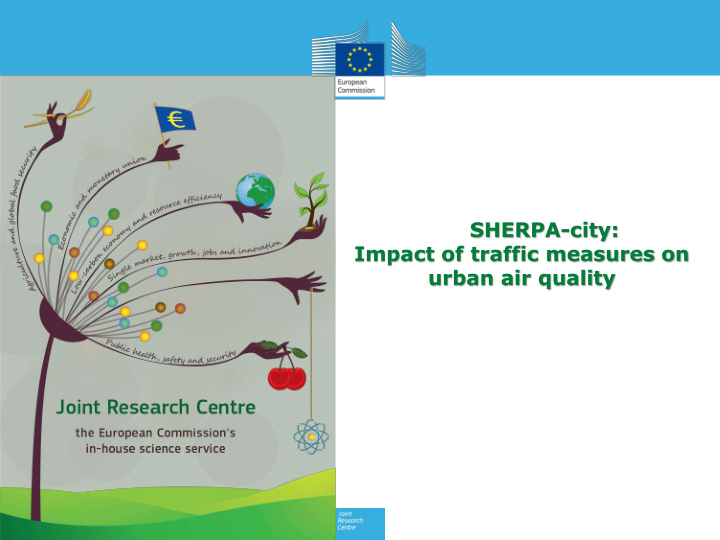



SHERPA-city: Impact of traffic measures on urban air quality
NO 2 is a local problem An analysis with SHERPA shows that the street and urban contributions are dominant the urban areas can solve their NO 2 problem. 2
What can cities do? • Introduction of a low emission zone (LEZ), typically a ban for older diesels and trucks. • Heavily debated diesel ban in Stuttgart: no pre-Euro 5 diesels from 10/2018 (?) • Reduce the amount of traffic with a tax. • Congestion charge in London • Area C in Milan • Promote a modal shift to public transport, walking and cycling. • ‘bike streets’, where cyclists have priority over cars But how to design these measures and assess their effectiveness? 3
The SHERPA-city approach • A webtool accessible to everyone (test version available) • To improve user-friendliness: • Selection of the study area on a map • A default road network with traffic flows is provided • Predefined vehicle fleets per country: • Current and future fleets • Typical LEZ fleets: e.g. no heavy duty vehicles, no pre-Euro 4 diesels • Fast calculation of concentrations with a kernel approach. • Kernel = annual average concentration around a unit (1 kg/h) emission source • The kernel depends on the weather conditions (wind speed and direction) 4
Kernel method • Focus on annual average: calculate the annual average concentration around a unit source. • Concentration depends on the local weather (wind speed, direction, temperature) Wind rose and kernel for Marseille, FR 5
Kernel method • Dispersion kernels are calculated in advance for the whole of Europe • Low concentrations and uniform kernels in windy coastal areas • High concentration and high variability in mountainous areas Maximum concentration of dispersion kernels over Europe for the same unit emission (1 kg/h) 6
Workflow (1) • Create a new project • Select the country and the year of the default vehicle fleet • Optional: import the background NO 2 and PM concentrations. • Select the study area (<100 km 2 ) 7
Workflow (2) • Edit the study area by: • • • Drawing or importing Modifying traffic Adding new roads or zones, e.g. a Low flow and road type. importing a road network Emission Zone from a shape file.
Workflow (3) • Scenario definition • Define new fleets (e.g. exclude pre Euro 4 diesels) • Assign fleets and traffic reductions to zones.
Workflow (4) • Compute and visualize results: • Bar plots with emissions per area and scenario for NO 2 , PM and CO 2 • Gridded concentrations and differences between scenarios and basecase for NO 2 and PM
An example Low emission zone in the city centre Dispersion kernel applied on emission to obtain concentrations Emissions without LEZ Local contribution to the concentrations without LEZ 11
An example Low emission zone in the city centre Dispersion kernel applied on emission to obtain concentrations Emissions with LEZ Local contribution to the concentrations with LEZ 12
Conclusions SHERPA city complements SHERPA, for analysis at high resolution Soon available on line for registered users Already available for interested cities for testing (please contact me in case) Future work: direct link between SHERPA and SHERPA city 13
Recommend
More recommend